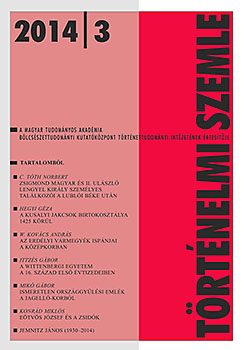A wittenbergi egyetem a 16. század első évtizedeiben
The University of Wittenberg in the early Sixteenth Century
Author(s): Gábor IttzésSubject(s): Higher Education , History of Education, State/Government and Education, 16th Century
Published by: Magyar Tudományos Akadémia Bölcsészettudományi Kutatóközpont Történettudományi Intézet
Keywords: University of Wittenberg; 16th century; Germany; reform of the university;
Summary/Abstract: The study surveys the first decades in the history of the University of Wittenberg. It examines the processes whereby a provincial, modestly conservative late medieval college developed into the flagship of German higher education and a leading university by European standards. The analysis approaches the institutional changes primarily on a structural level, reconstructing the process of transformation through a series of microanalyses made possible by the available sources. The University of Wittenberg was one of the most important scenes of the German Reformation in the 16th century, yet the institution did not owe its existence to the Reformation. Its foundation predates the start of the reform movement by some fifteen years. The university’s primary task was to provide the Electorate of Saxony with an expert bureaucracy. What emerges from the early sources is a picture of an institution whose intellectual outlook was determined by moderate Scotism. Key faculty positions were filled by professors with ecclesiastical benefices, i.e. canons, friars and monks. Although Humanism was present at Wittenberg from the outset, its role long remained subordinate to that of Scholasticism. Humanism had a limited presence in the course offerings, and remained virtually absent from the examination requirements. The reform of the university unfolded between 1518 and c.1526 in three phases. First, the Elector established seven new Humanist chairs at his own expense. In the wake of the Reformation, interest in the traditional lectures declined while student enrollment increased. Thus, in the second phase of the reform, in the early 1520s, both course offerings and university finances had to be profoundly reorganized. Traditional – Scholastic – courses were mostly removed from the curriculum. Consequently, however, degree requirements became impossible to meet, and by 1523 the old educational system had practically collapsed. In the third phase of reforms, between 1523 and 1526, the whole order of study was renewed in terms of both methodology and requirements under the direction of Melanchthon. Whereas previously Wittenberg merely followed the example of more prestigious universities or responded to changes within its own ranks, with the third wave of reforms it set the course for a transformation in the spirit of the Reformation not only for its own citizens but also for the entire system of German higher education. Although the next decade brought about further changes, in the light of the previous transformations these must be seen as minor corrections or the consolidation of the reforms. The Fundationsurkunde issued by the Elector in 1536 secured previous achievement and created the framework needed for a successful continuation of the university. Through an examination of the curriculum and the network of professorial chairs, the study analyses institutional structures, explores the mentality and educational program renewed under the influence of Humansim and Reformation, and also reconstructs the changing system of the university’s financing. It considers the role of the Electoral court, reflects on the teaching personnel, and discusses, in addition to the Faculty of Arts, which offered basic instruction, the transformation of the higher Faculties of Theology, Law and Medicine.
Journal: Történelmi Szemle
- Issue Year: 2014
- Issue No: 03
- Page Range: 423-453
- Page Count: 21
- Language: Hungarian

